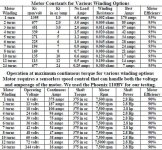SHARKBITEATTACK
10 W
Is ebikes.ca the only place to buy these now? I'm looking to buy a slow wind motor and run it at high voltage
John in CR said:Other than the ability to use smaller gauge wiring due to running a lower current, you gain exactly 0 by running a slow wind motor at high voltage vs a faster wind of the same motor at a proportionately lower voltage. Unfortunately the misconceptions that are causing Sharkbiteattack's desire to run such a configuration have been repeated so many times that many people treat it as fact.
veloman said:John in CR said:Other than the ability to use smaller gauge wiring due to running a lower current, you gain exactly 0 by running a slow wind motor at high voltage vs a faster wind of the same motor at a proportionately lower voltage. Unfortunately the misconceptions that are causing Sharkbiteattack's desire to run such a configuration have been repeated so many times that many people treat it as fact.
This has been discussed and I still don't see it. Explain to me how my 2810 accelerates faster than my 2806, on the same power of about 1700watts.
veloman said:John in CR said:Explain to me how my 2810 accelerates faster than my 2806, on the same power of about 1700watts.
John in CR said:More misinformation and misconceptions.
People are using apples and oranges. Use 80V for the 8 turn and 50V for the 5 turn. Set the battery resistance very low for both, so that doesn't create a difference. Then set the current limits in the opposite ratio, and you will get much closer to identical results. The 8 turn 9C will be slightly better efficiency across the board because it has the better copper fill at 64 strands compared to 60 for 5 turn.
Statements like Knighty's "the slow wind is more efficient at slow speeds" and Dogman's incessant sales pitch for the high turn count motors are how these myths perpetuate. Once you crank up the voltage to try to get to the same power then the house of cards come tumbling down. They can be more efficient a slower speeds, but that's at lower power. At the same voltage and lower current they are better at climbing hills or in stop-n-go congested traffic.
Identical motors of different winds are identical once you consider that you simply change the current and voltage proportionately for identical performance. Manufacturers who try to call the slow wind a high torque model are just misleading you. They're a slower wind period, and once you consider that our limitation is voltage, they're a lower power wind too. It works on hills, because it takes proportionately less power to climb a hill proportionately slower. Increase voltage to try to make it a fast motor too and that advantage you had at slower and lower power goes right out the window.
Don't bother with the anecdotal evidence to attempt to claim otherwise. All I have is fast wind motors and I climb steeper hills with heavier loads than most and never pedal assist on hills, but I've never melted a motor and don't even bother with temperature sensors. The motors I used from 2008 until the middle of this year are really no different than the motors people are using now, so don't credit it to some bigger, heavier, higher power motor. They're not magic either.

Lebowski said:OK, Jeremy, your equations etc are correct but don't describe what really goes on (I'm in Johns camp by
the way, and not only because he lives in a tropical countryso cold here now).
The 50V versus 100V battery, of course you want the same range from the system so your 100V is, for instance, 1P
while the 50V is a 2P battery. Then the losses in the battery are the same for both cases.
Same goes for the controller. At 50V you'll use 4110's while at 100V 4115's (as an example). Point is, the 50V
controller will have lower on-resistance FETs than the 100V controller such that the losses are the same again.
It all comes down to personal preference...
This is however not the correct scaling. Lets go to the (numerically easier) 100V and 50V example. Lets say the 100 V has 0.1 Ohm internal resistance. For 50V we split the 100V battery in 2 of 50V (each having 0.05 Ohm). As we want the same capacity we place the two 50V batteries in parallel and end up with 0.025 Ohm internal resistance. Factor 2 in voltage -> factor 2 in current but factor 4 in internal resistance.Jeremy Harris said:The 36V battery has an internal resistance of 0.036 ohms, the 55V battery has an internal resistance of 0.055 ohms (internal resistance has been scaled to reflect capacity and voltage)
Lebowski said:This is however not the correct scaling. Lets go to the (numerically easier) 100V and 50V example. Lets say the 100 V has 0.1 Ohm internal resistance. For 50V we split the 100V battery in 2 of 50V (each having 0.05 Ohm). As we want the same capacity we place the two 50V batteries in parallel and end up with 0.025 Ohm internal resistance. Factor 2 in voltage -> factor 2 in current but factor 4 in internal resistance.Jeremy Harris said:The 36V battery has an internal resistance of 0.036 ohms, the 55V battery has an internal resistance of 0.055 ohms (internal resistance has been scaled to reflect capacity and voltage)
So, if 55V has 0.055 Ohm 36V will have 0.0236 Ohm... 1000W taken will have 18.2W losses for both.
